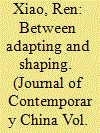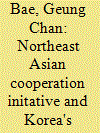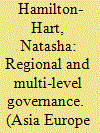| Srl | Item |
| 1 |
ID:
086325


|
|
|
|
|
| Publication |
2009.
|
| Summary/Abstract |
This paper attempts to examine the process of China's participation in regional cooperation in Asia and the factors that affect its participation. It focuses on a changing China-ASEAN relationship that is reshaping Asia. To build a peaceful and stable external environment, China has been making various efforts, political, economic and in the security field, to maintain and upgrade a harmonious and constructive relationship with its neighboring East Asian countries. Politically, China acceded to the Treaty of Amity and Cooperation in Southeast Asia (TAC), essentially accepting the code of conduct stipulated by ASEAN and prompting other regional countries to observe this code. China has been supportive of ASEAN, playing a leadership role in East Asian regional cooperation. China and Asian regional cooperation is an evolving concept and a couple of theoretical points may be taken into account, such as how regional cooperation influences major powers' international behavior and vice versa.
|
|
|
|
|
|
|
|
|
|
|
|
|
|
|
|
| 2 |
ID:
102786


|
|
|
|
|
| Publication |
2011.
|
| Summary/Abstract |
This paper explores how China's strategic motivations and calculations have both motivated and constrained its participation in East Asian regional cooperation. It argues that China's participation in regional economic and security cooperation is motivated first of all by the calculation of China's domestic interests to create a peaceful peripheral environment for its economic growth and political stability, particularly its frontier security and prosperity. The realist interests to enhance China's position in power competition with other major players in the region, particularly Japan and US, also play an important part in China's strategic calculation. These interest calculations, however, also set limits on China's participation in regional cooperation. These interest calculations have also shaped China's preference for an informal approach, emphasizing voluntarism and consensus building rather than legally binding resolutions, toward regional cooperation. This soft approach is a major barrier for many regional institutions to move beyond the stage of talking shops to effectively resolve conflicts in the region.
|
|
|
|
|
|
|
|
|
|
|
|
|
|
|
|
| 3 |
ID:
062189


|
|
|
|
|
| Publication |
Spring/Summer 2005.
|
|
|
|
|
|
|
|
|
|
|
|
|
|
|
|
| 4 |
ID:
111033


|
|
|
|
|
| Publication |
2012.
|
| Summary/Abstract |
Although the economies of East Asia emerged from the global financial crisis of 2008 in comparatively strong positions, they remain structurally embedded within global markets. The degree of regional integration that has occurred within East Asia is thus predicated on the on-going interdependence with the economies of Europe and North America. Moves to advance East Asian regional cooperation in the wake of the crisis reflect this global interdependence, as well as intra-regional differences in interests and a lack of strong leadership within the region. Modest cooperation on an East Asian basis has continued since 2008 but the region is very far from realising a substantive regional governance model on economic and financial issues and does not appear to be pursuing a distinctive governance agenda. This article examines recent developments in East Asian regional cooperation, with a view to assessing the significance of current achievements and explaining the mixed and sometimes contradictory nature of initiatives for regional governance in East Asia.
|
|
|
|
|
|
|
|
|
|
|
|
|
|
|
|